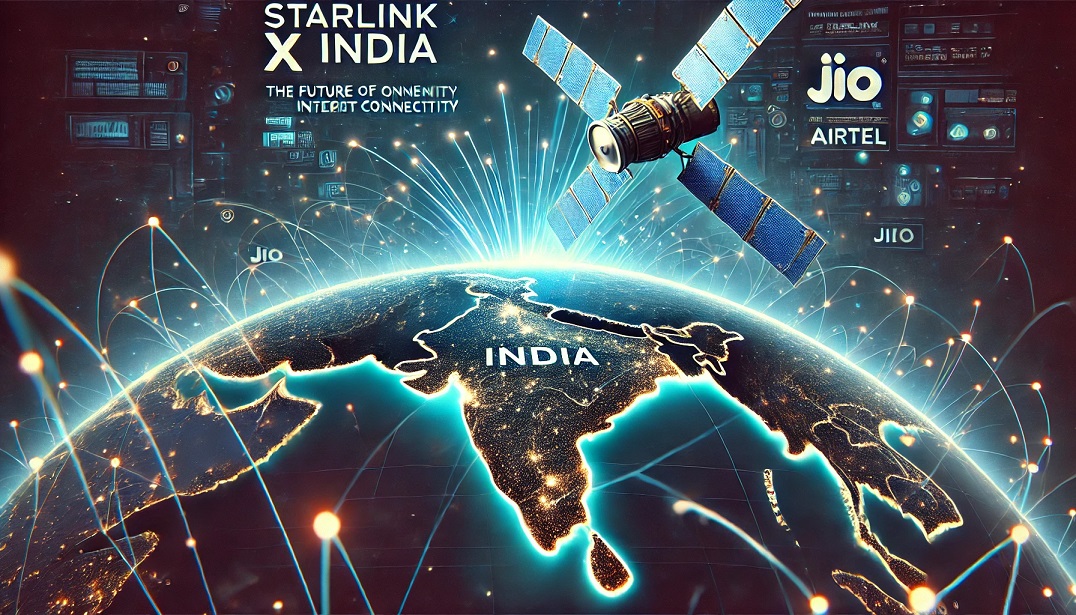🚀 Elon Musk’s Starlink is in talks with Indian telecom giants Jio and Airtel to expand high-speed satellite internet across rural India. 🌍 If approved, this could revolutionize India’s digital infrastructure. Learn more about the potential impact, benefits, and challenges. 📡✨
Elon Musk’s Starlink, the satellite-based internet provider under SpaceX, is taking a major leap forward by joining forces with Indian telecom giants to improve internet connectivity across rural and underserved areas. With Reliance Jio and Bharti Airtel reportedly engaging in discussions with Starlink, this collaboration could revolutionize digital accessibility in India. The initiative aims to provide high-speed, low-latency internet through satellite technology, bridging the digital divide and ensuring that even the most remote locations gain seamless online access.
As the deal awaits government approvals, experts are analyzing its potential impact on India’s telecom industry, rural internet expansion, and global broadband competition. But what does this mean for consumers, businesses, and the future of connectivity? Let’s explore.
🚀 Starlink and India's Telecom Industry: A Game-Changer in Connectivity
🌍 What is Starlink and How Does It Work?
Starlink is a low Earth orbit (LEO) satellite network developed by SpaceX to deliver high-speed internet anywhere on Earth. Unlike traditional broadband, which relies on fiber optics and cell towers, Starlink uses a constellation of satellites to beam internet directly to user terminals, bypassing infrastructure limitations.
💡 Key Features of Starlink:
✅ Speeds up to 250 Mbps – Comparable to urban broadband connections
✅ Low latency of ~20ms – Ideal for gaming, streaming, and video calls
✅ Global coverage – Works in remote locations where fiber and cellular networks fail
✅ Easy installation – Users only need a satellite dish and router
📡 Why is India the Next Big Market for Starlink?
📶 India's Internet Challenge: The Digital Divide
Despite having over 850 million internet users, India still faces significant connectivity gaps, especially in rural and hilly regions. Traditional ISPs struggle with infrastructure costs, network congestion, and fiber rollout delays. Satellite internet could be the solution, and Starlink's entry into India is seen as a disruptive force in the market.
📊 India's Telecom Giants in Talks with Starlink
Two of India's biggest telecom companies, Reliance Jio and Bharti Airtel, are reportedly partnering with Starlink to boost rural broadband services.
🔹 Reliance Jio – India’s largest telecom provider, known for its affordable 4G and 5G expansion, is eyeing a Starlink-powered satellite broadband service for remote villages.
🔹 Bharti Airtel – Already a major telecom player with a satellite service through OneWeb, Airtel might integrate Starlink’s technology to expand its coverage further.
🏆 The Goal? To ensure universal internet access across India, bringing millions of people online.
🚀 Potential Benefits of Starlink’s Expansion in India
📡 1. Internet for Rural and Remote Areas
✅ Over 300 million Indians still lack access to stable internet. Starlink’s satellite network can reach regions where fiber optics and 5G rollout are unfeasible.
⚡ 2. High-Speed Internet with Low Latency
✅ Unlike existing satellite internet, Starlink offers low latency (~20-40 ms), making it viable for video calls, online gaming, and stock trading.
💰 3. Economic Growth and Job Creation
✅ Reliable internet can boost local businesses, support education, and enable remote work, unlocking economic opportunities in rural India.
🛰 4. Strengthening India's Digital Infrastructure
✅ By integrating satellite internet into India's telecom ecosystem, Starlink could help India achieve its Digital India goals faster.
⚠️ Challenges and Drawbacks of Starlink in India
📜 1. Regulatory Hurdles and Government Approvals
❌ India’s Department of Telecommunications (DoT) has strict regulations for foreign satellite companies. Licensing approvals are required before Starlink can offer services.
💲 2. Pricing Concerns
❌ Starlink’s service currently costs $110/month + hardware ($599) – expensive for Indian consumers, where broadband plans start as low as $5/month.
📶 3. Competition from Existing Telecom Networks
❌ Airtel’s OneWeb, Jio’s 5G expansion, and India’s indigenous satellite broadband projects may challenge Starlink’s success.
🌏 4. Weather and Signal Disruptions
❌ Heavy rainfall, storms, and geographical barriers can affect Starlink’s performance, unlike fiber and 5G networks that provide more stability.
🔔 Latest News & Developments
🔹 Government Approvals Pending – Starlink has applied for regulatory clearance to operate in India. If approved, it could launch by mid-2025.
🔹 Potential Jio-Starlink Collaboration – Reports suggest Jio and Starlink may partner to deploy hybrid fiber-satellite networks, improving connectivity nationwide.
🔹 Rural Pilot Projects – Starlink has tested its services in remote villages, showing promising results for e-learning, healthcare, and e-commerce access.
🔹 India’s Own Satellite Broadband Push – The Indian government is also considering indigenous satellite-based broadband projects, increasing competition for Starlink.
🌟 The Future of Starlink in India: What to Expect?
🔮 Short Term:
- Regulatory clearance is key before Starlink can expand in India.
- Possible partnership announcements with Indian telecom firms.
🔮 Long Term:
- Starlink could become a major player in India's broadband market if it lowers prices and overcomes regulatory hurdles.
- It might reshape India’s rural economy, enabling better education, telemedicine, and digital financial services.
⭐ Verdict: If Starlink successfully enters India, it could transform internet access for millions and strengthen India's digital economy.

















Comments 0